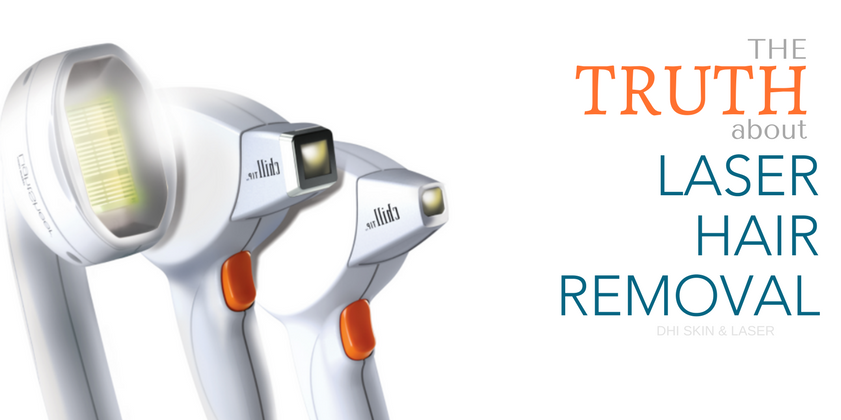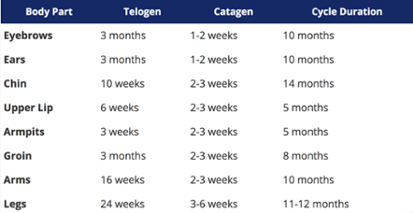When did body hair become so repulsive? In ancient days, hairy legs and armpits were just facts of life, not something to be scorned. Today, unwanted hair is clogging up shower drains, sticking to waxing strips and dulling razors all over the world. Both men and women are anxiously looking for solutions to removing these annoying tendrils. Here’s some statistics to back that up.
- 85% of American women regularly spend time removing unwanted hair daily
- Women who shave will spend over $10,000 on shaving products during their lifetime
- Women spend two entire months of their life shaving
- Women who wax 1-2 times per month end up spending about $23,000 on waxing products in their lifetime
- Men spend about $7,000 during their lifetime on shaving razors only!
- Men spend 45 days of their life shaving.
Options for Hair Removal
For years, the options for hair removal have been shaving, waxing, threading and even electrolysis (ouch!). The problems with these options is that results do not last and some of them may be quite painful.
According to the American Society for Dermatologic Surgery, laser hair removal is steadily on the rise, growing over 50% from 2012-2015 in procedures performed. This is likely due to the effectiveness and pain-free solutions found in modern technology.
How Does Laser Hair Removal Work?
Each laser (discussed below) works slightly differently, however the basic process is the same. The laser targets the pigment in the hair follicle, either through intense pulsed light (IPL) or by diode. The heat and energy combined are absorbed into the follicle, damaging the areas that produce the actual hair.
When this process is repeated over the growth cycle of the hair, the follicle will begin to stop producing hair. After each laser treatment, the hair that stems from that follicle will lose its course texture and the speed of growth will be significantly diminished after each treatment.
Read a more in-depth explanation of How Laser Hair Removal Works, here!
History of Laser Hair Removal Technology
As early as 1960, laser hair removal became a dream… a somewhat foggy dream. The very first laser was developed by Theodore H. Maiman. His early option for hair removal only slowed the growth of the hair, but also burned his patients somewhat severely.
In the 1970s, the first alexandrite laser was built. This technology forces radiation through an alexandrite crystal, reducing the growth of hair. This laser did not heat the follicle enough to actually provide permanent hair removal results. The process would have taken years to provide a permanent solution.
The problem with these early solutions was that the laser could not target a hair follicle without adversely affecting the surrounding skin. Scientists finally crafted a laser in 1984 that targeted the hair follicle, rather than the skin, providing much safer and more effective results.
The Difference Between Electrolysis and Laser Hair Removal.
There are several differences between electrolysis and LHR.
Currently, electrolysis is the only FDA approved procedure for permanently removing hair. The process involves sticking an epilator device or probe that emits radio frequency into the follicle, damaging the follicle, causing current hair to fall out and prohibit the further growth of new hair.
LHR uses targeted light, heat or radiation to pinpoint the hair follicle, causing the hair follicle to shrivel and be less effective at growing new hair. New hair can grow from the follicle, however the hair will be thinner lighter and grow much more slowly than growth at a normal rate.
Find out the specifics on how Laser Hair Removal works, here!
Types of Lasers for Laser Hair Removal
There are five main technologies that have been and are still being used today to eliminate unwanted body hair. All of these lasers do require follow-up and maintenance treatments.
- Ruby
- This is the oldest solution for laser hair reduction and is still widely used. The pain level is lower compared to other solutions, but only works well on light skin colors. This laser is unique in that it can target blonde and thin hair, not solely dark, thick hair.
- Alexandrite
- The Alexandrite laser is considered the fastest laser for LHR and targets the melanin in the skin. This laser uses radiation that passes through an alexandrite crystal to eliminate hair growth. The down side to this solution is that it truly only works best on light to olive skin tones and is quite painful.
- Diode
- A diode laser for LHR uses light and heat to specifically target the melanin in the hair follicle, which in turn protects the surrounding skin. When the pigment absorbs the energy, it is destroyed, inhibiting the growth of new hair. This laser is unique in that it can work on even darker Fitzpatrick skin types.
- Nd:Yag
- In proper terms, Nd stands for Neodymium, and ” YAG” is short for yttrium aluminum garnet. When this laser is used for hair removal, a carbon lotion is placed on the skin, which is then absorbed by the hair follicle. This liquid then attracts the wavelengths from the laser, targeting the follicle and remaining hair pigment.
- IPL
- An IPL laser uses Intense Pulsed Light to penetrate the skin and target hair follicles specifically without damaging the surrounding skin. An IPL laser is attracted to pigment, making those with fair skin and dark hair the best candidates. The main benefit of this laser is the ability to control with wavelength penetrating the skin.
Is Laser Hair Removal Permanent?
The only permanent hair removal solution approved by the FDA is electrolysis. Laser hair removal is better coined as permanent laser hair reduction. This just means that it is possible for hair to grow in the treated areas, however, after a laser treatment, the hair will be much thinner and even lighter, if anything grows at all.
There are hormonal caveats to this as well. Women who suffer from PCOS (polycystic ovarian syndrome) may not see the same results as someone without this disease and will definitely require more treatment sessions.
Also, women who undergo hormonal changes, such as after childbirth or post menopause may experience renewed hair growth. However, the hair will never be as thick as it once was.
Is Laser Hair Removal Painful?
Depending on the laser used and the settings of the laser, yes, laser hair removal can be painful. This is one reason why it is important to be selective when choosing a certified laser hair technician to perform this treatment. Not only can the skill level of the laser technician impact your results, they are also in control of the wavelengths that will affect your pain threshold.
The ruby laser, mentioned above is one of the more pain-free options available because of the delay in the wavelengths, allowing the area to recover in-between pulses.
The diode laser, mentioned above as well is as close to painless as possible. At Derma Health, we use the Lumenis Lightsheer Desire technology, a diode laser with a cooling tip to ensure maximum comfort during the procedure. There is also a vacuum effect that pulls the skin as close to the energy source as possible, which does two things. First, the energy is pointedly directed to the follicle and second, blood flow is temporarily restricted to reduce discomfort even further.
When Will You See Results After Laser Hair Removal?
Seeing results after laser hair removal is dependent upon genetics, what stage the hair is at in it’s growth cycle and the part of the body treated. For some, results can be seen the next day, whereas others may wait a few days to even a weeks to see results (not typical). Continue reading for further explanation.
How Many Treatments Do You Need with Laser Hair Removal?
There is no definitive answer as to how many treatments are required for permanent hair reduction, due to genetics and hormones, hair growth cycles and the body part that is treated.
At Derma Health, our typical patient receives six treatments per area for optimal results. Other lasers may require 4-12 treatments per area. As with all lasers, maintenance treatments, usually between 1-2, are required each year.
Why Do You Need Multiple LHR Treatments?
Hair grows in a cycle and at any given time can be in one of three distinct phases: growth stage (Anagen), transitional (Catagen) and resting stage (Telogen). Laser hair removal only targets hair that is in the “growth” stage, and any number of hairs may be in this or a different stage. Because of this process, multiple treatments are necessary.
Further, each body part has a different length of the growth cycle. Some areas may require you to come in every two weeks, whereas other body parts like the legs may only require treatments every six to eight weeks.
What To Do Before a LHR Appointment
Preparation for a laser hair removal appointment is pretty simple, however there are a few items to highlight. Talk with your specific clinic provider before your appointment for more specific instructions.
- Do not tweeze, wax or use any chemical epilation three weeks prior to your appointment.
- It is best to avoid tanning or direct sun for seven days prior to the appointment. This includes sunless tanning products as well. These lasers target pigment or color in the skin, so in order to reduce discomfort, sun exposure should be limited.
- The treatment areas should be clean and shaven 24 hours prior to the appointment.
- Do not exercise or perform any activity that would elevate blood pressure or internal heat for at least two hours before your appointment.
- Some cosmetic products contain alpha hydroxy and beta hydroxyl (AHA/BHA), hydroquinone, retinols/retinoid, Tazorac, and Differin. Avoid these products for seven days prior to treatment.
- Wait at least two weeks after any chemical peels or Botox / filler appointments before getting LHR.
- You must be off of and similar treatments for six months before being treated.
- Antibiotics have been known to increase photo sensitivity, so finish any course of antibiotics and wait seven days before your LHR appointment.
- Clients who are pregnant or have epilepsy are not candidates for laser hair removal.
What To Do After a LHR Treatment (post care)
Depending on the type of laser treatment used, aftercare may slightly differ. You may experience redness, swelling, red bumps and irritation and cold compresses or a acetaminophen (like Tylenol) can be taken if necessary (highly unlikely).
After a treatment, skin is at a higher risk for sunburn, so stay out of direct sunlight for at least seven days and even avoid sunless tanning solutions. When getting sun exposure, be sure to use a full spectrum sunscreen for protection. Avoid any further laser treatments or chemical peels for at least two weeks.
Continue your daily hygiene and maintenance on a regular basis. The areas should be washed, exfoliated and shaved as needed to prevent ingrown hairs and to allow hair growth turnover.
To learn more about Laser Hair Removal aftercare, click here!
What Are Adverse Side Effects and Risks of Laser Hair Removal?
There are very few side effects to laser hair removal, but a select few may experience some discomfort, swelling or redness. On an even smaller scale, patients may experience:
- Blisters or burns (due to improper settings)
- Cold sore outbreaks
- Infections (due to improper cleansing of equipment)
- Scarring
- Pigmentation changes (skin lightening or darkening)
Most of these side effects subside in a matter of days, however, permanent damage is possible. This is why it is vitally important to ensure your laser tech is properly certified and has experience administering the laser treatment.
What is the Best Laser for Laser Hair Removal?
At Derma Health, we believe the best option for long lasting results is the diode LightSheer Desire from Lumenis. The benefits of this laser include:
- Virtually pain free
- Works on all skin types
- Multiple hand pieces for different body areas
- ChillTip™ technology for increased comfort
- Fast treatment
- 805 nm diode for optimal results
- High patient satisfaction
Who Can Perform Laser Hair Removal?
Each state is unique in their certifications and regulations for laser technicians to perform laser hair removal. Some states have very few requirements and the term “certified laser technician” may only mean a person has attended a private laser administration class given by vendor.
Arizona was actually the first state that enacted required mandatory training hours to be legally certified to perform laser and IPL treatments. Further, this training can only be completed at a state approved facility.
In addition to laser hair certification, some states have taken their precautions a step further in requiring the laser tech to also hold a cosmetology or aesthetics license. An even small number of states require a medical professional, such as a doctor or nurse to perform the LHR treatments.
Questions to Ask Your Laser Technician
In order to ensure safety and optimal results, ask your laser technician the following questions.
- What protective equipment will I be given during the procedure?
- Are you familiar with the nominal hazard zones of the laser equipment?
- Have you received Laser Safety Officer training?
- Are you familiar with the wavelength settings on the Fitzpatrick Scale?
- Are you prepared to handle any adverse side effects, if they should happen?
- How long have you been performing laser hair removal procedures?
- Have you had any complaints from clients either during or after the treatment?
- What type of training have you received for this procedure?
- How long have you worked with this particular machine?
- Have you experienced this treatment yourself?
Your laser technician should be able to comfortably be able to answer each of these questions without hesitation. While there are very few negative side effects for laser hair removal, you can never be too cautious when undergoing a laser or skin treatment.
What Areas of the Body Can Receive Laser Hair Removal?
Just about any area of the body can safely undergo laser hair removal, except the eye area (sorry, you have to keep you eyelashes).
The five most common areas that men and women target are:
- Face (chin, cheeks, lip)
- Chest
- Back
- Underarms
- Legs/Bikini area
Other areas include, arms, back of the neck and jawline (for men), hands, feet, shoulders, Brazilian area, stomach, abdomen…etc.
For men specifically, laser hair removal is growing in popularity because they can now use the technology to ‘clean up’ the back of their necks, to give a clean shaven look. No more do they need to frequent the local barber shop to get ‘cleaned up’ in the back. Also, men who are balding or completely shave their heads are able to permanently reduce the hair on top of their head.
How Much Does Laser Hair Removal Cost?
Pricing for laser hair removal is dependent upon the size of the area being treated, the machine that is being used and the number of treatments needed for optimal results. When inquiring about pricing, be sure to ask if the price quoted is for a single treatment or for a series of treatments.
On a broad scale, laser hair removal costs between $150 – $900 per treatment. According to American Society of Plastic Surgeons, the average price of LHR is $429 per treatment.
DocShop.com compiled a list of average pricing for various body parts.
While the price point may be high, it is wise to remember that the average woman spends over $10,000 in her lifetime on shaving products and men spend over $7,000. Compare that cost with time spent shaving and removing unwanted hair and these prices are a steal.
Who is a good candidate?
For most lasers, the best candidate for laser hair removal is someone with light skin (low Fitzpatrick) and dark, course hair. These candidates respond the fastest to the laser technology. This is not to say that someone with darker pigment or a higher Fitzpatrick will not benefit from the laser, the results may take longer to achieve. Choosing a clinic with the appropriate laser for your skin type (discussed above) is vital for optimal outcomes.
The laser chosen by Derma Health can effectively treat ALL SKIN TYPES and ethnicities.

Not long ago, those with blonde or vellus hair were not able to benefit from laser hair removal because the lasers were unable to target the little pigment in the follicle. Depending on the laser, darker blondes now have an option for removing unwanted body hair as well.
Further Reading:





